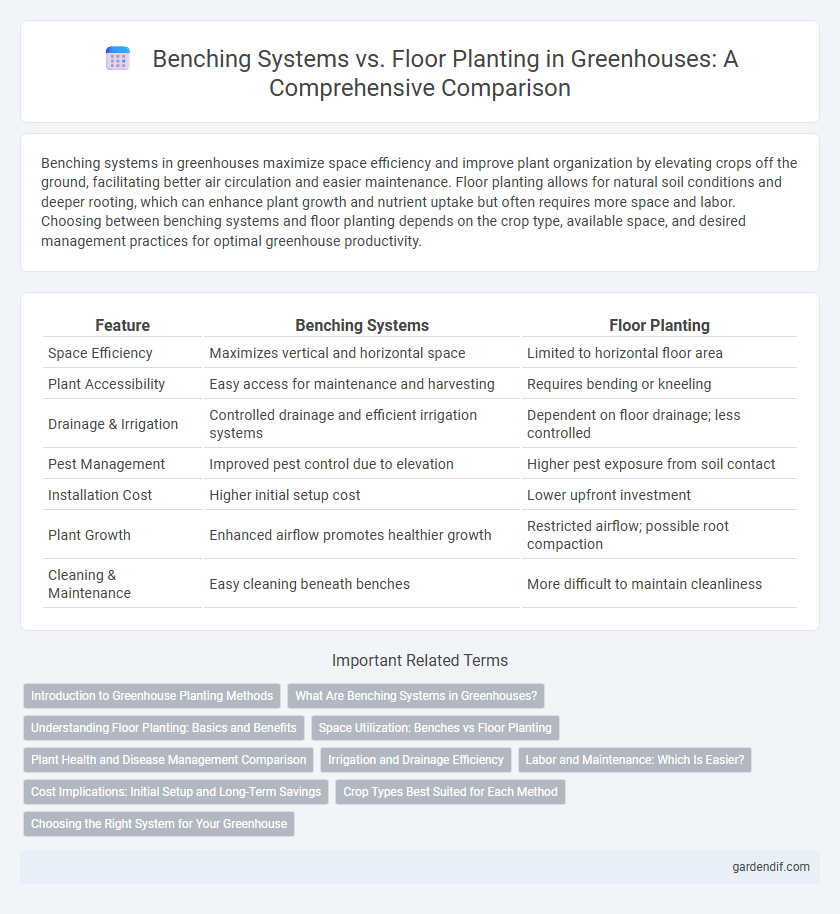
Benching Systems vs Floor Planting Illustration
Benching systems in greenhouses maximize space efficiency and improve plant organization by elevating crops off the ground, facilitating better air circulation and easier maintenance. Floor planting allows for natural soil conditions and deeper rooting, which can enhance plant growth and nutrient uptake but often requires more space and labor. Choosing between benching systems and floor planting depends on the crop type, available space, and desired management practices for optimal greenhouse productivity.
Table of Comparison
| Feature | Benching Systems | Floor Planting |
|---|---|---|
| Space Efficiency | Maximizes vertical and horizontal space | Limited to horizontal floor area |
| Plant Accessibility | Easy access for maintenance and harvesting | Requires bending or kneeling |
| Drainage & Irrigation | Controlled drainage and efficient irrigation systems | Dependent on floor drainage; less controlled |
| Pest Management | Improved pest control due to elevation | Higher pest exposure from soil contact |
| Installation Cost | Higher initial setup cost | Lower upfront investment |
| Plant Growth | Enhanced airflow promotes healthier growth | Restricted airflow; possible root compaction |
| Cleaning & Maintenance | Easy cleaning beneath benches | More difficult to maintain cleanliness |
Introduction to Greenhouse Planting Methods
Greenhouse planting methods primarily involve benching systems and floor planting, each offering distinct advantages for plant cultivation. Benching systems maximize space efficiency and improve air circulation by elevating plants above ground level, reducing pest risks and facilitating easier maintenance. Floor planting allows for larger, soil-based crops with natural moisture retention but may require more extensive pest management and watering controls.
What Are Benching Systems in Greenhouses?
Benching systems in greenhouses consist of raised platforms or tables designed to hold plants, improving space utilization and accessibility compared to floor planting. These systems enhance air circulation, reduce soil-borne diseases, and facilitate easier watering and maintenance. By elevating plants off the ground, benching systems optimize growing conditions and increase overall productivity in commercial greenhouse operations.
Understanding Floor Planting: Basics and Benefits
Floor planting in greenhouses involves growing plants directly in the ground or growing beds, offering natural soil conditions, enhanced root growth, and better water retention compared to benched systems. This method allows for larger root development and improved microclimate control, which supports healthier plants and higher yields. Floor planting reduces initial infrastructure costs and simplifies irrigation and drainage management, making it a cost-effective choice for certain crops.
Space Utilization: Benches vs Floor Planting
Benching systems in greenhouses maximize vertical space, enabling efficient plant arrangement and increased crop density within limited square footage. Floor planting consumes extensive ground area, often resulting in underutilized vertical space and reduced overall plant capacity. Optimizing space with benching improves airflow, lighting uniformity, and maintenance accessibility, enhancing crop yield per square meter.
Plant Health and Disease Management Comparison
Benching systems in greenhouses improve plant health by enhancing air circulation and reducing humidity around foliage, decreasing the risk of fungal diseases compared to floor planting, where stagnant air and soil moisture promote pathogen growth. Elevated benches facilitate better drainage and allow for easier monitoring and sanitation, minimizing cross-contamination and disease spread. Floor planting often increases exposure to soil-borne pathogens and pests, challenging disease management efforts and compromising overall plant vitality.
Irrigation and Drainage Efficiency
Benching systems in greenhouses enhance irrigation efficiency by facilitating targeted water delivery directly to plant roots, minimizing water waste compared to floor planting. Elevated benches improve drainage by preventing water accumulation and promoting rapid runoff, reducing the risk of root diseases caused by waterlogging. Floor planting often struggles with uneven water distribution and slower drainage, leading to increased irrigation needs and potential crop stress.
Labor and Maintenance: Which Is Easier?
Benching systems in greenhouses significantly reduce labor by organizing plants at waist height, minimizing bending and heavy lifting compared to floor planting. Maintenance tasks such as watering, pruning, and pest control are more efficient with benching systems, allowing quicker access and better plant visibility. Floor planting often requires more manual effort to manage uneven surfaces and heavier soil handling, increasing labor intensity and maintenance time.
Cost Implications: Initial Setup and Long-Term Savings
Benching systems in greenhouses generally require higher initial setup costs due to construction and materials but provide long-term savings by optimizing space and improving crop management. Floor planting involves lower upfront expenses but can lead to increased labor costs and less efficient use of greenhouse area over time. Choosing benching systems can enhance operational efficiency and reduce maintenance costs, resulting in better financial returns in the long run.
Crop Types Best Suited for Each Method
Benching systems are ideal for high-value, small-to-medium crops such as herbs, leafy greens, and seedling trays that require precise environmental control and easy access for maintenance. Floor planting suits larger, sprawling crops like tomatoes, cucumbers, and melons that benefit from extensive root space and natural ground support. Selecting the appropriate method enhances crop yield by aligning plant growth habits with optimal greenhouse infrastructure.
Choosing the Right System for Your Greenhouse
Benching systems maximize growing space by elevating plants, improving air circulation and drainage while facilitating easier maintenance and harvesting in greenhouse environments. Floor planting offers flexibility for large or irregularly shaped crops but may lead to soil compaction and increased pest exposure, requiring more intensive management. Selecting the right system depends on crop type, greenhouse size, and operational goals, balancing efficiency with plant health to optimize productivity.
Benching Systems vs Floor Planting Infographic

 gardendif.com
gardendif.com